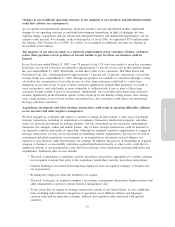Electronic Arts 2007 Annual Report Download - page 88
Download and view the complete annual report
Please find page 88 of the 2007 Electronic Arts annual report below. You can navigate through the pages in the report by either clicking on the pages listed below, or by using the keyword search tool below to find specific information within the annual report.Likewise, if a key event to which our product release schedule is tied were to be delayed or cancelled, our
sales would also suffer disproportionately. Our ability to meet product development schedules is affected by a
number of factors, including the creative processes involved, the coordination of large and sometimes
geographically dispersed development teams required by the increasing complexity of our products and the
platforms for which they are developed, and the need to fine-tune our products prior to their release. We have
experienced development delays for our products in the past, which caused us to push back release dates. In
the future, any failure to meet anticipated production or release schedules would likely result in a delay of
revenue and/or possibly a significant shortfall in our revenue, harm our profitability, and cause our operating
results to be materially different than anticipated.
Our business is intensely competitive and “hit” driven. If we do not continue to deliver “hit” products
and services or if consumers prefer our competitors’ products or services over our own, our operating
results could suffer.
Competition in our industry is intense and we expect new competitors to continue to emerge in the United
States and abroad. While many new products and services are regularly introduced, only a relatively small
number of “hit” titles accounts for a significant portion of total revenue in our industry. Hit products or
services offered by our competitors may take a larger share of consumer spending than we anticipate, which
could cause revenue generated from our products and services to fall below expectations. If our competitors
develop more successful products or services, offer competitive products or services at lower price points or
based on payment models perceived as offering a better value proposition (such as pay-for-play or
subscription-based models), or if we do not continue to develop consistently high-quality and well-received
products and services, our revenue, margins, and profitability will decline.
Technology changes rapidly in our business and if we fail to anticipate or successfully implement new
technologies or the manner in which people play our games, the quality, timeliness and competitiveness
of our products and services will suffer.
Rapid technology changes in our industry require us to anticipate, sometimes years in advance, which
technologies we must implement and take advantage of in order to make our products and services competitive
in the market. Therefore, we usually start our product development with a range of technical development
goals that we hope to be able to achieve. We may not be able to achieve these goals, or our competition may
be able to achieve them more quickly and effectively than we can. In either case, our products and services
may be technologically inferior to our competitors’, less appealing to consumers, or both. If we cannot achieve
our technology goals within the original development schedule of our products and services, then we may
delay their release until these technology goals can be achieved, which may delay or reduce revenue and
increase our development expenses. Alternatively, we may increase the resources employed in research and
development in an attempt to accelerate our development of new technologies, either to preserve our product
or service launch schedule or to keep up with our competition, which would increase our development
expenses.
The video game hardware manufacturers set the royalty rates and other fees that we must pay to
publish games for their platforms, and therefore have significant influence on our costs. If one or more
of these manufacturers adopt a different fee structure for future game consoles, our profitability will be
materially impacted.
In order to publish products for a video game system such as the Xbox 360, PLAYSTATION 3 or Wii, we
must take a license from the manufacturer, which gives it the opportunity to set the fee structure that we must
pay in order to publish games for that platform. Similarly, certain manufacturers have retained the flexibility
to change their fee structures, or adopt different fee structures for online gameplay and other new features for
their consoles. The control that hardware manufacturers have over the fee structures for their platforms and
online access makes it difficult for us to predict our costs, profitability and impact on margins. Because
publishing products for video game systems is the largest portion of our business, any increase in fee
structures would significantly harm our ability to generate revenues and/or profits.
14
























